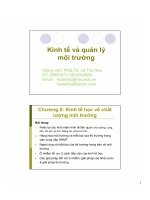Bài giảng kinh tế quốc tế giáo viên nguyễn hữu lộc chương 1 nhập môn
Bạn đang xem bản rút gọn của tài liệu. Xem và tải ngay bản đầy đủ của tài liệu tại đây (2.34 MB, 40 trang )
to International Economics
December 5, 2016
GV NGUYEN HUU LOC UEH
1
Tài liệu bắt buộc
December 5, 2016
GV NGUYEN HUU LOC UEH
2
Chương 1
Tổng quan - Introduction
Mục đích giúp sinh viên
- Biết chủ đề và phương pháp nghiên cứu môn học
- Hiểu rõ các xu hướng phát triển chính của thương mại quốc tế ngày nay
- Vai trò của toàn cầu hóa kinh tế
- Các thách thức hiện nay của kinh tế quốc tế
Nội dung
- Toàn cầu hóa kinh tế thế giới
- Thương mại quốc tế và living standard của quốc gia
- Dòng di chuyển hàng hóa, dịch vụ, lao động và vốn quốc tế
- Lý thuyết và chính sách kinh tế quốc tế
- Các vấn đề và thách thức của kinh tế quốc tế
December 5, 2016
GV NGUYEN HUU LOC UEH
3
What is Globalisation?
• The shift towards a more integrated and
interdependent world economy.
• Economic globalisation involves a shift
toward a system based on a
consolidated global market place for
production & consumption rather than
on autonomous national economies
(Lubbers, 2000)
December 5, 2016
GV NGUYEN HUU LOC UEH
4
Paul Krugmann’s definition
• “Toàn cầu hóa không chỉ là vấn đề Quốc tế
hóa thương mại mà là loàn cầu hóa sản xuất
với bốn xu thế:
1. Giảm khả năng tạo giá trò gia tăng VA (why?)
Vì vậy, khi khả năng tăng VA sản ph ẩm thấp
thì việc chọn lựa nơi sản xuất trên cơ sở so
sánh chi phí hoạt động, thông tin liên lạc
thấp, các lợi ích đem lại từ lợi thế đònh vò kinh
tế cung cấp bởi nước chủ nhà là quan tâm
hàng đầu của các công ty toàn cầu
December 5, 2016
GV NGUYEN HUU LOC UEH
5
Paul Krugmann’s definition
2. Các nước có chi phí nhân công thấp tham gia ngày
càng thường xuyên hơn, nhiều hơn, vào quá trình trao
đổi quốc tế.
3. Có những nước và những vùng trung tâm, không thể
tự sản xuất phục vụ thỏa mãn nhu cầu tiêu dùng của
mình, mà phụ thuộc vào thương mại và nhập khẩu để
bảo đảm xuất khẩu.
4. Xuất hiện sự phụ thuộc qua lại trong công nghiệp nội
ngành. Nghóa là gần như tất cả các nước cùng lúc nhập
khẩu và xuất khẩu hàng hóa của một ngành công
nghiệp
December 5, 2016
GV NGUYEN HUU LOC UEH
6
Tồn cầu hố v.s Quốc tế hố
Toàn cầu hóa là Quốc tế hóa cộng với yếu tố vùng
mà doanh nghiệp không thể đánh giá thấp.
• Global factories không nhất thiết phải sản xuất tại
những đòa điểm nhất đònh: có thể sản xuất ra
những sản phẩm phù hợp, đáp ứng điều kiện của
bất cứ quốc gia nào.
• Global factory NOT limited to
manufacturing
• Eg. Software development and
distribution for global banking firms
•
December 5, 2016
GV NGUYEN HUU LOC UEH
7
Dimensions of Globalisation
December 5, 2016
Markets Production Capital
GV NGUYEN HUU LOC UEH
8
Economic Dimention
International Integration
Trade/investment organisations (multilateralism)
• Rules of the game
Multinational corporations (latecomers)
• Players
Trade & investment (acquisition, marketing, finance)
• The game
Countries (Triad + BRICs + Developing countries)
• The playing field
Check this out:
Friedman, Thomas L. (1999) The Lexus and the Olive Tree: Understanding
Globalization, Farrer, Straus & Giroux.
December 5, 2016
GV NGUYEN HUU LOC UEH
9
Globalisation of Markets
Exploitation and creation of global
market segments, ie. ipod, Cocacola, industrial goods (chemicals)
-Google Earth & iphone
/>
Standardisation of products,
packaging, promotion
Converging tastes and trends worldwide
Alternative view:
Naomi Klein No Logo: Brands, Globalization & Resistance
/>December 5, 2016
GV NGUYEN HUU LOC UEH
10
Globalisation of Capital
• International institutions (gold standard)
• Floating currencies
• Instantaneous international capital transaction and
transfer
International portfolio investment
• Rise (and fall) of global financial institutions
Contagion effect (eg. Asian financial crisis, US sub-prime mortgage
market)
Video:
The End Of Globalisation – World – Globalisation at a crossroads
/>December 5, 2016
GV NGUYEN HUU LOC UEH
11
Novel Features of
Globalisation today
• Follows a prolonged period of inward orientation
(protectionism)
• International players include governments (whose role is
declining) as well as MNEs, multilateral agencies, NGOs
• Dramatic increase in flows of trade, investment, people
• Growing importance of international production (deep
integration) over trade and capital movements (shallow
integration)
• Information and knowledge driven
• Extended international division of labour
December 5, 2016
GV NGUYEN HUU LOC UEH
12
Implications of A Global World
• Economic activities formerly under national control
now under MNE control eg.capital, privatised assets
• National economies (ie. countries) linked through
markets (trade) and through international production
(FDI)
• Economic (business) linkages reinforced by crossborder flow of norms, values, business culture
• Market-based economic systems
December 5, 2016
GV NGUYEN HUU LOC UEH
13
Drivers of Globalisation
1.
2.
3.
4.
5.
6.
MNES
Transportation technology
Communications technology
Political ideology-peace
Liberalisation of trade/investment
Movement of people
December 5, 2016
GV NGUYEN HUU LOC UEH
14
1. MNEs
•
•
•
•
•
Trade
Finance
FDI
M&As
Alliances
•
•
•
•
1970 - 700 MNEs, 1998 - 60,000 (with 500,000 foreign affiliates)
1997 FDI reached its peak, MNEs accounted for 25% of world GDP,
33% of world exports
1970, US$10-20b exchanged daily on currency markets
1997 FDI is growing faster than international trade – 39% increase
MNEs are so large and powerful that they have replaced nation-states as
the defining power structures of the global economy - of the world's
100 largest economies, 51 are corporations
2007 FDI peaked again - rising by 30% to reach $1,833 billion
2008 FDI declined by 15% due to the global financial crisis
Approximately 79,000 MNEs, and 790,000 affiliates
200 MNEs now control over ¼ world economic activity
Forex market today = US$trillions
December 5, 2016
GV NGUYEN HUU LOC UEH
15
2. Transportation Technology
The Shrinking Globe Transportation
1500 -1840
Best average speed of
horse-drawn coaches
and sailing ships, 10
mph.
1850 - 1930
1950s
1960s
Propeller Jet
Steam locomotives aircraft passenger
average 65 mph.
300 - 400 aircraft,
Steamships average mph.
500 - 700
36 mph.
mph.
Today:
Supersonic flight
(Concorde)
Singapore Airlines
A380 – 500+
passengers, speed
Mach 0.89
©The©The
McGraw-Hill
Companies,
Inc., 2000 Inc., 2000
McGraw-Hill
Companies,
December 5, 2016
GV NGUYEN HUU LOC UEH
16
3. Communications Technology
•
The world is
• 1990-95 - TV sets per thousand people doubled to 235
witnessing
• Mid-1990s - number of minutes of international
unprecedented
telephone communications doubled to 70 billion
transformation into
an information-based • 1998 - 140 million Internet users in 1998, by 2002 there
were 600 million
society.
• 2000 – 12% of the world owned a mobile phone
• This is driven by
major technological
Implications for the spread of knowledge …
changes in
Over half the GDP in major OECD
communications and
countries is knowledge-based.
computers.
2000-2008 Internet users – tripled to 1,464 millon
22% internet penetration (from 74% N.A to 5% Africa
Mobile phone use expected to reach 50% of world’s population (3.3
billion subscribers) in 2008
December 5, 2016
GV NGUYEN HUU LOC UEH
17
4. (Relative) Peace
•
Dominance of US
market forces and
capitalism – but not
always peacefully!
•
•
•
•
•
•
Rise of emerging
markets, especially
China and continued
dominance of Europe,
coupled with financial
problems in the US may
undermine this
dominance
Rise of politically and
faith-motivated conflict
Multipolar world?
December 5, 2016
End of the Cold War
Change towards Capitalism and Market Ideology, but also
communism socialism still dominant in parts of Asia, Latin America
Bases of Power
–Colonial control (1870s-1945) – Imperialist power
–Cold war rivalry between Soviet/US blocs (1945-1990) – Military
power
–Informal, economic competition (1990 onwards) – Economic power
Today:
Terrorist acts
New US president (new view?)
Economic power
Implications for the future?
GV NGUYEN HUU LOC UEH
18
5. Liberalisation
• Unprecedented levels of
economic cooperation
between countries,
especially with regard to
trade
• International capital
markets
1980s • Macroeconomic stability – reduction of
fiscal deficits
• Reduced role for government – deregulation
and privatisation
• Greater openness to the outside-reduced
trade and investment barriers
• Multilateral and
supranational governance
(G20)
TODAY
•Almost all new regulations and agreements serve to promote trade and
investment
• Regional economic integration is now firmly embedded in Europe, growing in
North (and to a lesser extent, South) America, and rapidly increasing in Asia
December 5, 2016
GV NGUYEN HUU LOC UEH
19
6. Movement of People
In the 20th Century, the world’s population grew
from 1.6 to 6 billion – 2 billion in the last 30 years
Population growth concentrated in developing
countries, and in cities
TODAY
•World population = 6.7 billion, 3.2 billion live in cities, 3.4 in
rural areas
• Population growth has slowed to 1.3%
• 190 million (3%) immigrants, 13.5 are refugees
• South-South and South-North immigration
• Travel - almost 900 million tourist arrivals
TOMMOROW
• 2 billion added to world population in the next 30
years
•Concentrated in developing countries, urban areas
December 5, 2016
GV NGUYEN HUU LOC UEH
20
Globalization of production
December 5, 2016
GV NGUYEN HUU LOC UEH
21
Another example of global sourcing (BMW)
– Automaker BMW employs 70,000 factory personnel at 23
sites in 13 countries to manufacture its vehicles.
– The Munich plant builds the BMW 3 Series and supplies
engines to other BMW factories abroad.
– The South Carolina plant makes 500 vehicles daily.
– A plant in NE China makes cars in a local joint venture.
– A plant in India makes BMWs for the Asian market.
– BMW configures sourcing to minimise costs (by producing
in China), access skilled personnel (by producing in
Germany), and remain close to key markets (by producing
in China, India, and the United States).
December 5, 2016
GV NGUYEN HUU LOC UEH
Thương mại quốc tế và living standard quốc gia
• Sự phụ thuộc tương hổ giữa các quốc gia
December 5, 2016
GV NGUYEN HUU LOC UEH
23
Thương mại quốc tế và living standard quốc gia
• Sự phụ thuộc kinh tế tương hổ giữa các
nước có xu hướng tăng
December 5, 2016
GV NGUYEN HUU LOC UEH
24
Vai trò thương mại quốc tế đối với kinh tế Hoa Kỳ
December 5, 2016
GV NGUYEN HUU LOC UEH
25









